Weekend Update #119: Fighting Men With Machines Is A Good Thing: Ukraine Should Aim To Do More And More Of It
Also--Russian Advances Slow; Ukraine's Kursk Offensive Is 6 Months Old
Hello All,
Its notable how Russian advances have slowed down in the last week. That presents a bit of a problem to the press, which has been telling us for months that Ukrainian morale was about to break and that the Russians were about to take Pokrovsk, etc. It does seem, however, that instead of acknowledging what we are seeing, the press is still expecting some form of Ukrainian failure, though it is stuck trying to explain why it is taking so long. The theme of the last week seems to be saying that Ukrainian failure is being staved off desperately as the Ukrainians are having to rely on machines to fight men—as if this were a bad thing.
Hint, it is the best thing possible.
Also, I thought I would mention to those who missed it, that I did my first video cast this week—with Rep Adam Kinzinger. We spent most of our time on US politics, but also delved into the Russo-Ukraine War. We both shared an incredulity towards the idea that this Russian Army cant be beaten. Adam, a former member of the USAF, even tried to calculate how long it would take the US to destroy the Russians from the air.
Fighting Men With Machines Is A Good Thing: Ukraine Should Aim To Do More And More Of It
Ukraine is using drones to fight infantry and it seems in the press that this is a sign that they are in bad shape. The Wall Street Journal, which is usually been one of the better papers on the war reporting and hasn’t written the endless pieces about collapsing Ukrainian morale that appear in other outlets, produced a major piece on this phenomenon.
Its amazing how this is being presented. Basically Ukraine is being forced to rely on machines instead of using manpower to fight the Russians because they seem to have no alternative. The Russians are portrayed as marching inexorably on Pokrovsk (more on that below) in infantry led assaults that can never fully be stopped by UAVs). Ukraine’s reluctance to conscript more forces is again in the crosshairs, as it is said (based overwhelmingly on anecdotal evidence—which is extremely frustrating) that Ukraine is outnumbered by 10-1 in soldiers in this area.
Here is a description in another paper of that piece.
“We just don’t have enough people to defend Pokrovsk,” a 25-year-old infantry platoon commander told the WSJ of the dire situation near the eastern hotspot.
He said despite Russia’s high casualty of roughly 7-to-1 compared to Ukraine, Kyiv troops were outgunned by 10-to-1 in that sector and likely require 10 times more troops to effectively halt Moscow’s advances near Pokrovsk.
That stories can be written like this shows how little modern war remains understood—and indeed how balance is desperately needed in reporting what is happening on the battlefield. For example, we have lots of pessimistic Ukrainian quotes and none from Russians.
Lets start with the basic lesson of war in the 20th and 21st centuries. The idea that it is a bad thing to fight men with machines is the exact opposite of what we have seen. During that time the move has been in the exact opposite direction—to do exactly what Ukraine is doing and using machines to do the fighting to conserve soldiers’ lives. It has been a particularly key element of US military policy since World War II.
The fundamental nature of Franklin Roosevelt’s World War II mobilization policy was to create a force where American machines did the fighting in place of American soldiers. In his mind, this would keep US casualties down and allow for a more efficient form of warfare.
I actually wrote a substack last summer on Roosevelt as war leader—which made precisely this point (it was part of the release of my book The Strategists). For subscribers who want to read it—here is the link.
And here is an encapsulation of Roosevelt’s thinking—explaining why US casualties were so low in World War II compared to the other powers.
US deaths were so low because of how Franklin Roosevelt conceived of modern war. Having visited the Western Front in World War I, Roosevelt, the Assistant Secretary of the Navy at the time, came away convinced that the land war was to be minimized as a rule. He hated the smells, sounds and sights of the land war—was repulsed by the odors of death and garbage, hated sleeping in close quarters in fortresses (he spent the night in Verdun) and viewed much of the slaughter he witnessed as unnecessary.
Roosevelt wanted machines to do most of the heavy lifting in war—not human beings. He believed that the industrial/technological capabilities of the United States should foremost be used to gain sea (and later air) dominance over key supply routes, and using that the US should grind their enemies into dust.
In Roosevelt’s case it was a spectacular success. US military deaths (I go through that in the piece) were just over 400k in all theaters and services during the war. The Japanese, in comparison, lost 2 million and the Germans between 5-6 million.
It was a damn good thing for the US soldier that machines did much of the fighting.
What this means is that Ukraine would/should be trying to do exactly this—even if it had more infantry. The last thing Ukraine should be doing is packing the front lines with more troops—something the Ukrainians have understood for a while.
Indeed, the Ukrainians have been trying to replace the use of soldiers with machines for a while yet. In December 2024 it was reported that in the area to the north of Kharkiv, the Ukrainians launched an all-machine assault on Russian forces. In it, the Ukrainians combined the use of Unpiloted land vehicles (armed with machine guns) with UAVs patrolling overhead to attack Russian lines.
And it makes sense. Neither vehicles nor infantry seem to have much of a long life-span once they reveal themselves in this battlefield. Constant UAV patrolling and the ubiquity of attack drones has led to an extremely high toll on each. And the force exchange mechanism definitely favors the machines.
Ukraine in 2024 was expected to produce 4 million UAVs—and construction rates seem to be going up. If Ukraine can exchange 3 UAVs for every Russian soldier lost, the Russian army would dissolve in short order
So these arguments, that Ukraine is struggling by using machines to fight manpower, gets the narrative of war and technology completely upside down. If Ukraine had lots of extra infantry they would still want to fight Russian manpower with machines. The last thing the Ukrainians would want to do is stuff their front-line (which can be hit by Russian firepower, Russian drones, Russian glide bombs) with lots of troops. As this war has shown, that is a fool’s game with modern weaponry.
In other words, Ukraine would be wanting to do this anyway. The fact that they are able to fight men with machines, and Russian advances are slowing and getting more bloody (see next story) is a positive sign.
Russian Advances Slow
So, how is the infantry-packed Russian army doing now? Well, far from smashing through Ukrainian lines, the last few weeks have seen a real slow down in Russian advances—indeed the last week it has been particularly noticeable—especially around Pokrovsk which has been supposedly about to fall for more than half a year now.
Here is a map of the battle area around Pokrovsk right now according to Deep State. Note: the scale here is ridiculously small considering the size of the front. If you look at the distance marker in the bottom left, you can see that one inch equals about 2 miles.
And here is the exact same map two weeks earlier.
In two weeks Russia has advanced a few hundred yards towards Pokrovsk. They have not yet broken the main defensive line, and the Russian advance is actually in a weak position. Even if you go back 5 weeks from today—the situation is only marginally ahead of where it was.
I see a 2 kilometre advance in 5 weeks—to reach the undoubtedly strategic metropolis of Kotlyne.
Note—if you are new to this—that is me being sarcastic. Nothing here is strategic—not even Pokrovsk.
Why is this Russian advance particularly weak? Well because they are having to try and go cross country as they cant control a road. Because they go cross country, they cant bring in supplies or heavier equipment easily, which means that the bulge is actually less threatening than it looks on a map.
And, actually many Ukrainians who know the area well, and who sadly never get interviewed by the western media, are now presenting a very different position on the fighting there. Here is the text from a radio interview of a Ukrainian officer, Oleksii Herman, head of the electronic warfare service of the 111th brigade, whois fighting in the area (the below and more quotes can be found here).
Q. Is the intensity of enemy actions really decreasing? Is it because they’ve felt the pressure, or are there other factors at play?
A. After a day on duty, I can say the intensity has dropped significantly. The enemy has suffered considerable losses, and it seems they are struggling to recover.
Q. When you say they’re struggling to recover, what do you mean? There were reports before of enemy units being wiped out and reinforcements arriving almost immediately. Is that still happening, or are there other obstacles, like the nature of modern warfare?
A. The situation for them is dire — both their cities and logistics are destroyed. Take places like Bakhmut, Chasiv Yar, New York, and Toretsk. There’s no infrastructure left. It’s winter now, and there’s a 3-kilometer “gray zone” between us and them. As soon as we see movement, technology allows us to detect it, and drones are deployed immediately. They don’t even make it to our positions—they’re taken out before they get close.
Q. Let's talk about the Pokrovsk direction. With Lieutenant General Drapatyi now leading the Khortytsia OSUV and additional brigades there, what changes can we expect? Can Pokrovsk hold?
A. I wrote about Pokrovsk a year ago. After the Bakhmut and Chasiv Yar fortresses, Pokrovsk became another stronghold. The front line in Pokrovsk and Myrnohrad is stabilized. The enemy is stopped there, but they’ll try to bypass us from the flanks. They’re unlikely to succeed. If we get reinforcements, shells, and everything else needed for war, they have no chance. The enemy is demoralized and disheveled. Even prisoners we capture have no desire to fight. They just say, "We didn’t want to be here. They're shooting at us, there’s no way out."
Is the situation around Pokrovsk great for Ukraine—almost certainly not. However it is not collapsing, Ukrainian morale does not seem to be collapsing, Russian losses are very high indeed, and Russian advances have slowed significantly. December 2024 and January 2025 have been by far the two months with the heaviest Russian losses in the war according to British intelligence. So far in February the Russians are losing forces at a similar clip (while gaining less ground).
Maybe once it would be nice to read that in a story.
Ukraine's Kursk Offensive Is 6 Months Old
On Thursday, President Zelensky marked the 6 month anniversary of the Ukrainian offensive into Russia—the Kursk operation. In his address he spoke of the operation’s importance to Ukraine.
"With our active operation on Russian territory, we have brought the war home to Russia, and it is there that they must feel what war is. And they do,"
Zelensky went on to say that the operation showed that even with limited resournces, Ukraine can "act decisively, unexpectedly, and effectively…We are exposing Russia’s bluff for what it is – a bluff,"
Guess what—it is still too early to give a definitive answer to whether the operation was worth it (because we dont have reliable loss figures for it on both sides). However, beyond the questions of losses—the fact that Ukraine has taken and held a large slice of Russia is undoubtedly a factor in their favor if talks start soon.
All the discussions of a frozen conflict (which is the basis of the Trump peace plan—more on that later in the week), were based on the assumption that the fighting would be limited to Ukraine. If Putin cant force Ukrainian troops out of Russia, and he is failing to do that, even with the use of North Korean forces) than he will have to make a major concession to convince Ukraine to leave Russia. Its hard to think of another thing that Ukraine could have to bargain with, with such force.
Oh, and the Ukrainians actually advanced more in Kursk this week than the Russians advanced towards Pokrovsk.
Here is the map of the Kursk salient right now:
Here it was a week ago—notice the Ukrainians have advanced about 2miles out from Makhnovka.
Its taken Russia about a month to advance that far towards Pokrovsk.
Have a good rest of the weekend everyone.



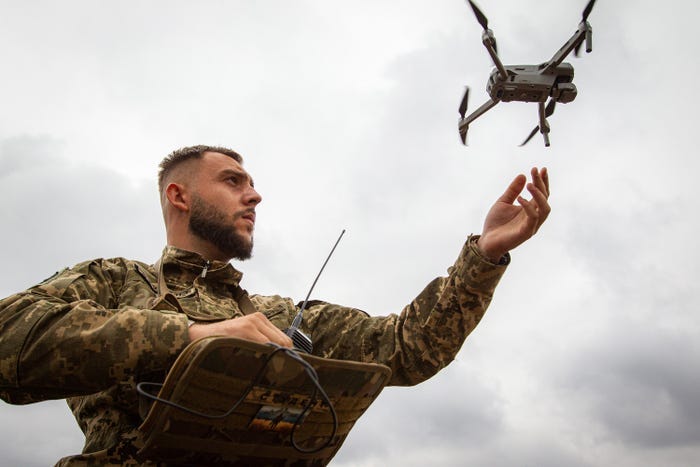

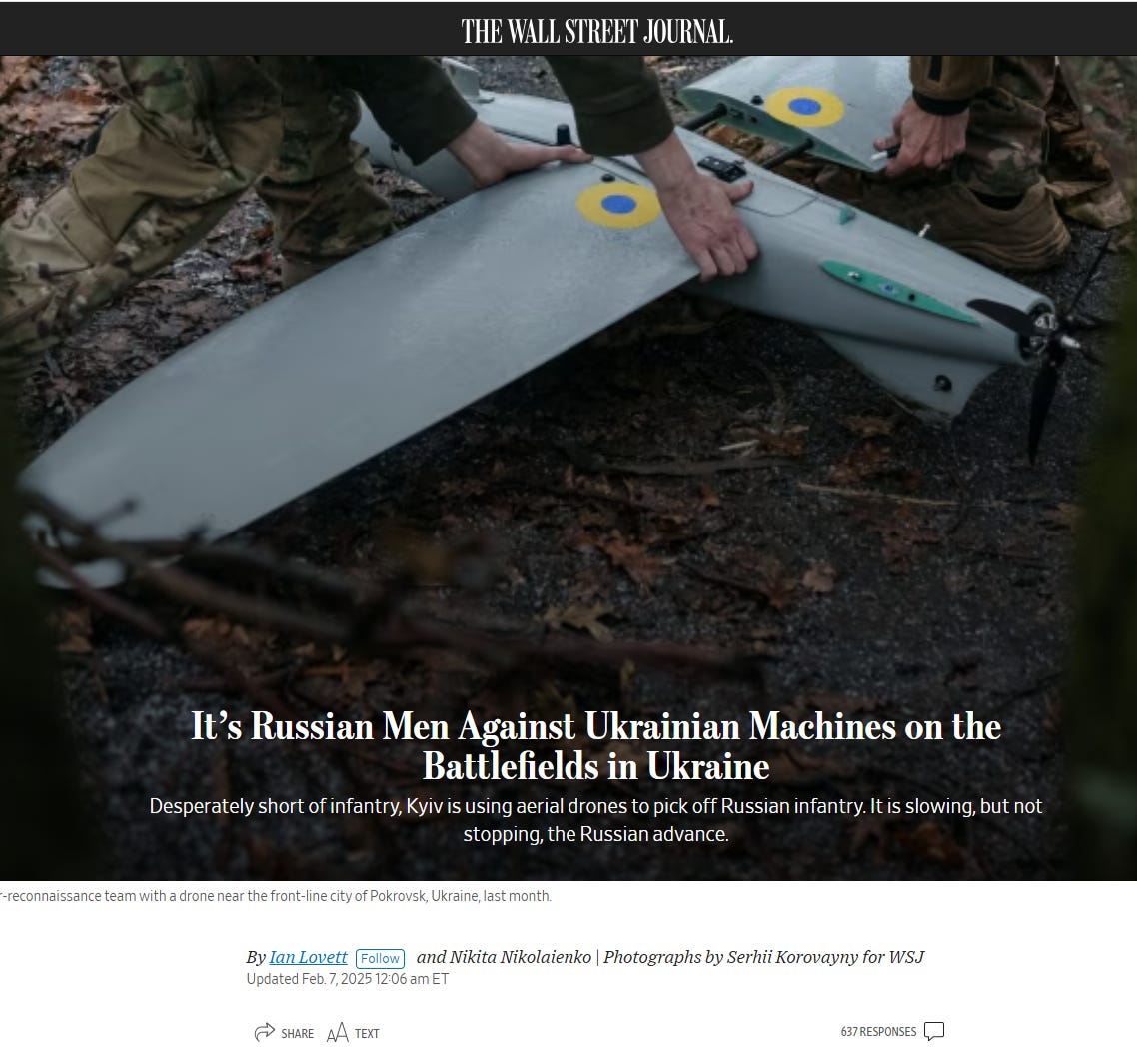
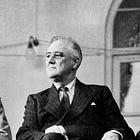
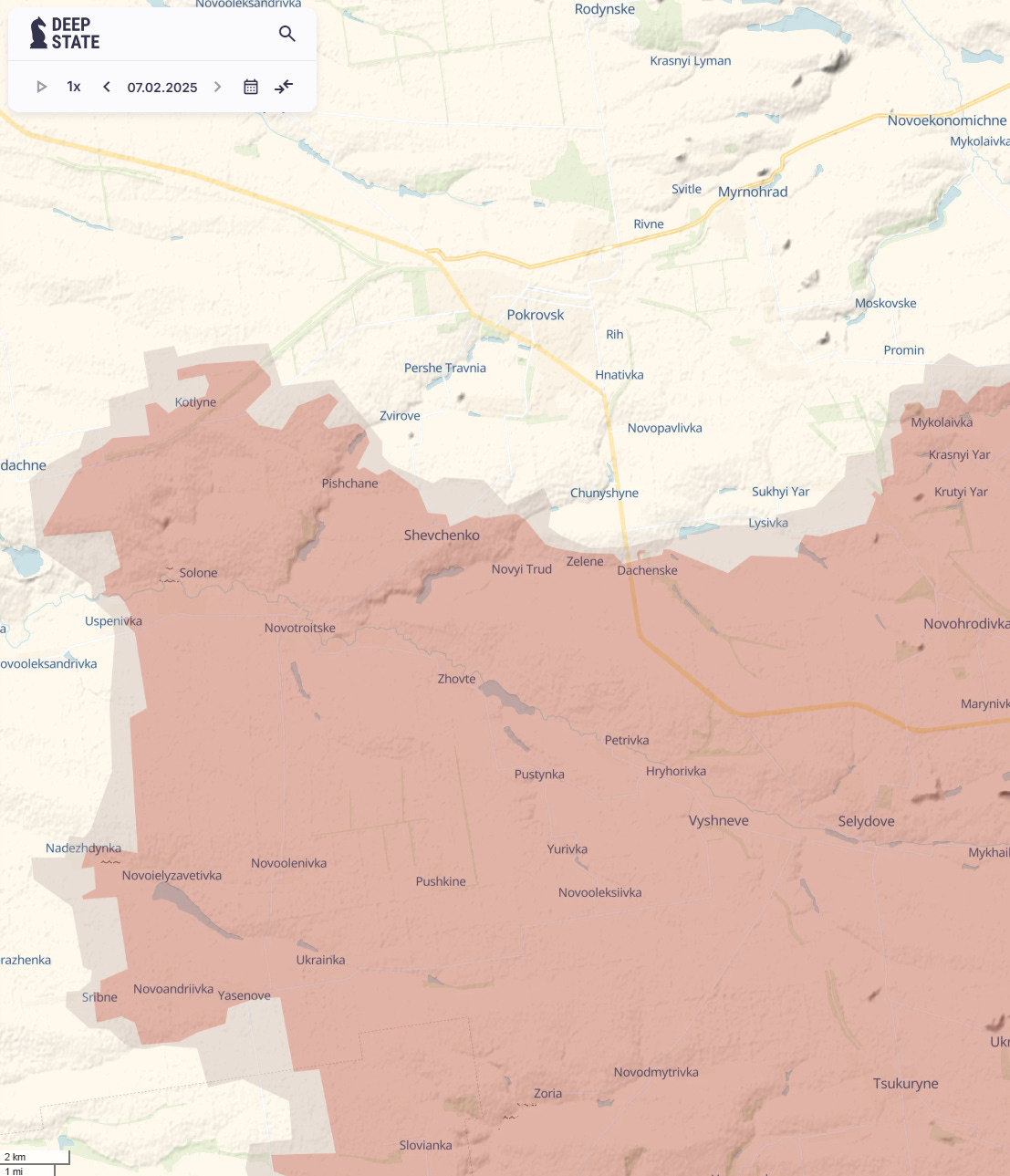
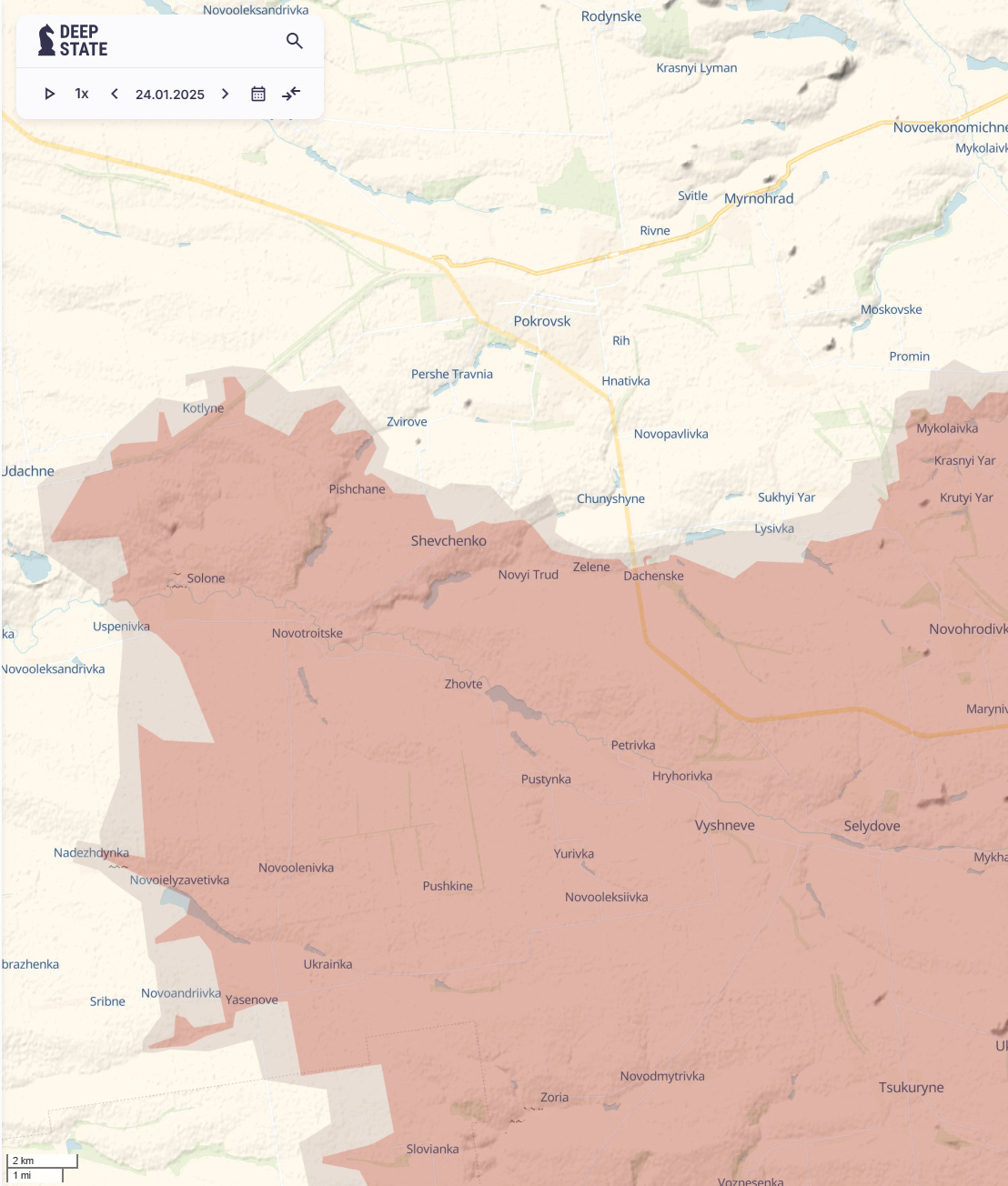
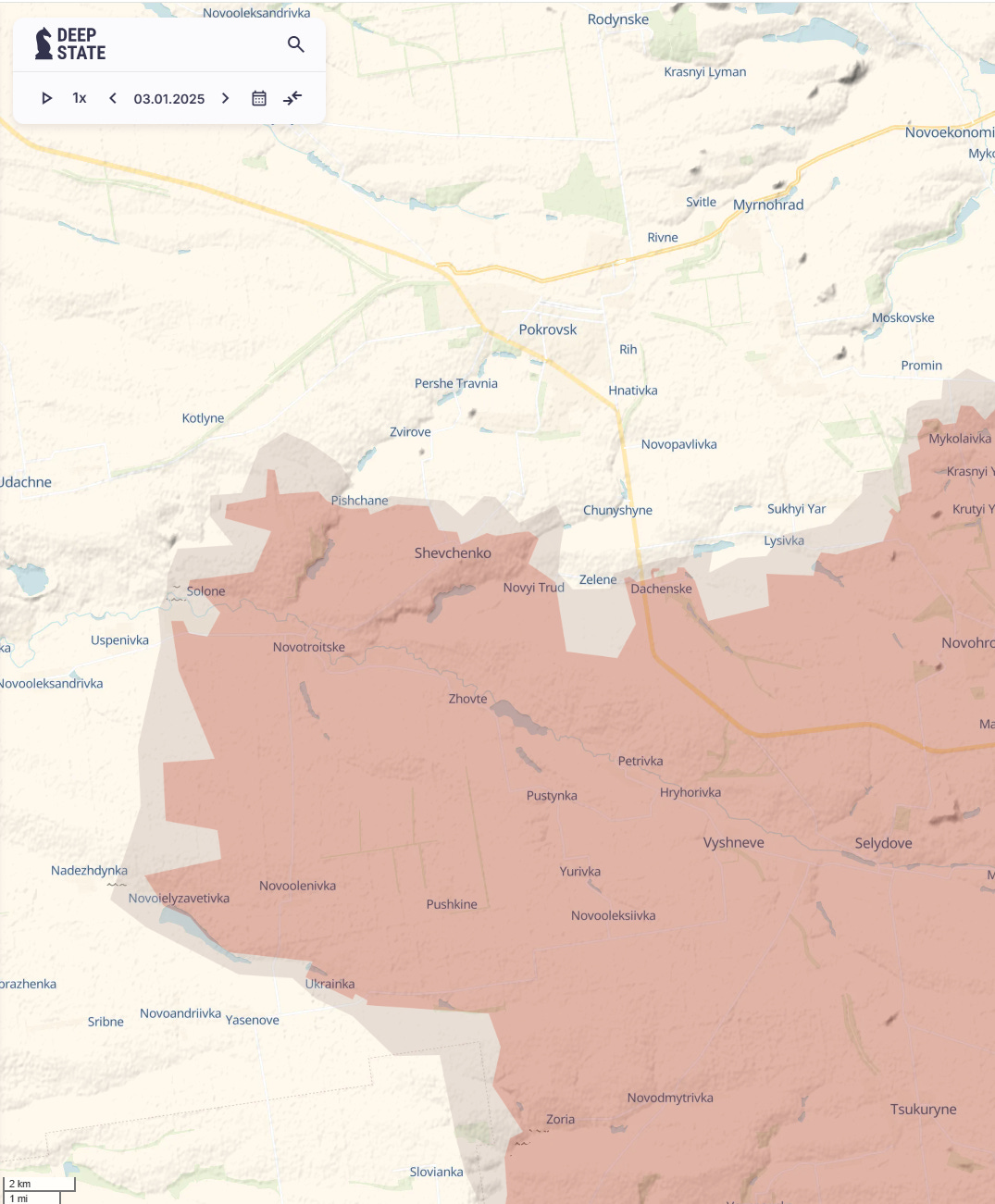
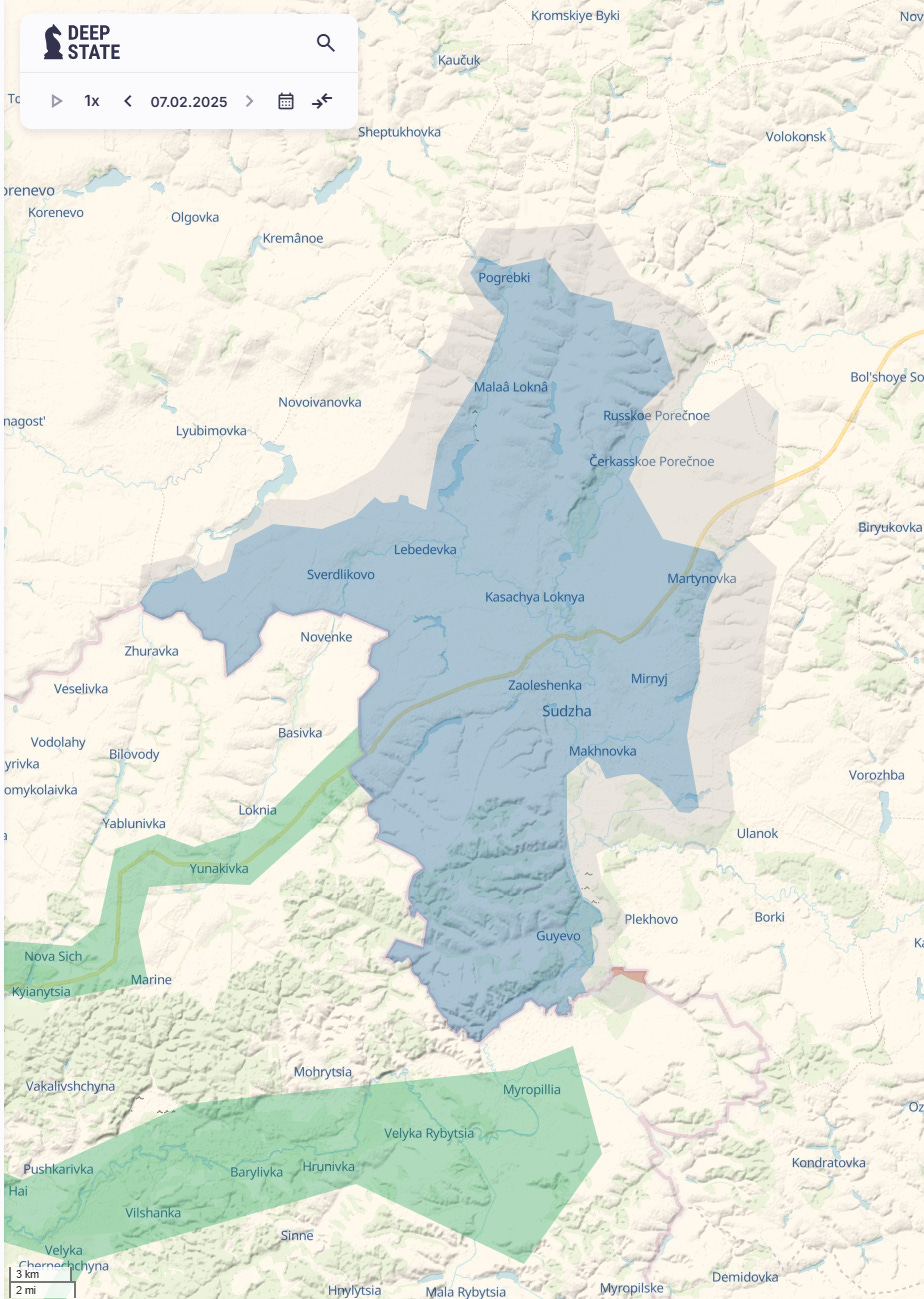
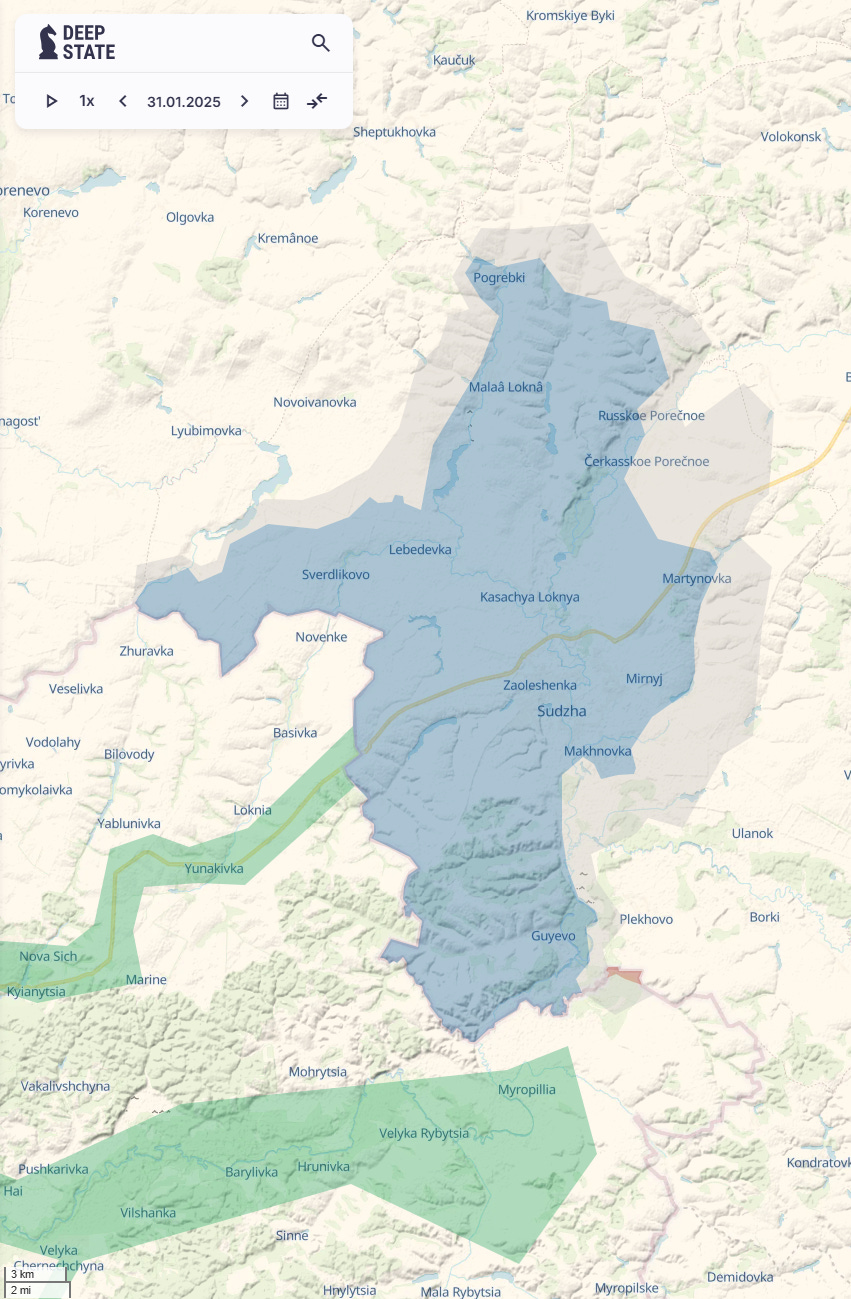
Phillips, thanks again for a useful update.
The recent all drone offensive operation in Kharkiv, I believe was a proof of concept. As you have stated Ukraine has built significant numbers of drones but reporting has focussed primarily on air drones with little attention on the advancements they have made on their ground drones. What we have seen is technological advancements, led by Ukraine, that have or are creating the potential for offensive operations based on this technology with the aim of destroying the enemy, air dominance and only utilising troops to mop-up. Their ground drones include engineering systems that enable them to overcome obstacles and I know that they are developing "swarm" technology for their air drones. Given the numbers that they are producing, this I believe will form the vanguard of any future offensives this year.
I subscribe to the WP but given their totally unrealistic reporting means I no longer consider it a reliable check on what is happening. Unfortunately, I paid a full years subscription and cannot undo that.
The Ukranian Officer's perspective is encouraging and I am still convinced that this is the year that Russia reaches an inflection point. However, the turd in the punch bowl is Trump, but again President Z and his European supporters are playing a very clever game of not showing their hands. The Daily Mail recently published "Trumps" peace plan. I believe it was BS but I also think that the Trump administration was testing the water to see what the reactions were (Trump has history). It was interesting that President Z called it Russian propaganda thus maintaining a non-confrontational position regarding Trump.
Phillips, you still have a very negative opinion of European support and with cause, but I am still firmly of the opinion that Trump will fail to acknowledge Ukraines independence and favour Russia which will result in the fighting continuing and in a fit of pique Trump will exclude himself from any influence. Europe, or more to the point, a part of Europe and the UK will continue their support and I hope increase it.
Putin is a dead man walking, he just doesn't realise it, as is normally the case with most authoritarians until it is too late. Just look at Romania.
Thanks indeed for this novel and highly interesting perspective on the course of the war. Just after reading your piece, I found this account of the all drone attack that your refer to in Tim Mak's Counteroffensive substack: https://www.counteroffensive.news/p/the-first-ever-all-drone-assault?utm_source=substack&utm_medium=email#media-834af911-5c62-454a-b2e4-7450229a1f20. it makes for fascinating reading. Maybe the Ukrainians are the first ones to usher in the future of warfare.